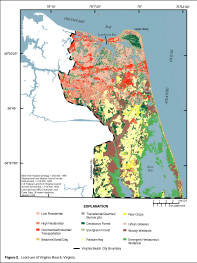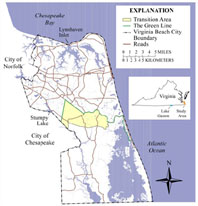|
|
The City of Virginia Beach |
Virginia Beach is a growing city in southeastern Virginia with a limited supply of fresh water. Most of the city’s drinking water, up to 45 million gallons per day, comes from Lake Gaston. The Lake Gaston pipeline supplies water for the northern half of Virginia Beach, but the southern rural boroughs rely solely on ground water (Johnson, 1999).
Privately owned wells also provide water from shallow depths throughout Virginia
Beach. The shallow wells provide water for homeowners and small to
moderately sized businesses including golf courses and farms. Supplies of ground water are limited, however, because of high
concentrations of iron, manganese, chloride and (or) sulfide ions in some
areas. The shallow aquifers are also dewatered by several sand-and-gravel mines. At depths greater than approximately
150 to 200 ft, the water is generally
too saline to drink
The purpose of the Virginia Beach shallow aquifer study is to better understand the distribution of fresh ground water, its susceptibility to contamination, and its sustainability as a long-term water supply.
The city of Virginia Beach has an interest in preserving the limited supply of water in the shallow aquifers for drinking, irrigation, lawn watering, heat pumps, and potentially for desalination. The U.S. Geological Survey (USGS), in cooperation with the City of Virginia Beach Department of Public Utilities, began a cooperative study of the shallow aquifer system in 1996.
 Virginia Beach land use |
During this study, the USGS has collected continuous cores and geophysical logs from the shallow aquifer system and revised the conceptual hydrogeologic framework of the system (Smith and Harlow, 2002). A water-level and water-quality network has been established in the city and continuous water-level records have been collected for several wells. The USGS also simulated ground-water flow and the distribution of saline water, as indicated by chloride concentration, in the shallow aquifers of the southern watersheds of Virginia Beach (Smith, 2003). Slow, but steady movement of chloride concentrations toward a hypothetical well field pumping from the York-Eastover aquifer was simulated, as well as, drawdowns around hypothetical open-pit mines in the Columbia aquifer. In 2004, the USGS and the Virginia Department of Public Utilities will expand the observation-well network and simulate ground-water pumping from the shallow aquifers in the Transition Area. |


